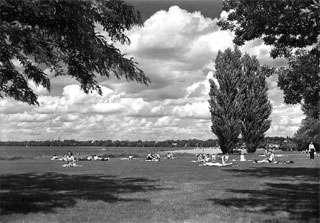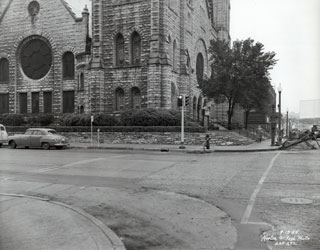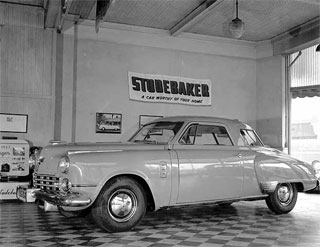Martha Turner Doughty: Perfect Neighbors
Post-war suburbanites in the Twin Cities metro area found that they didn't have to go far to find good company and entertainment. Just as schools and health care facilities followed the migration of people to the suburbs, so did churches, movie theaters, bowling alleys, and shopping centers. Sometimes the wide open spaces bordering the suburbs created recreational opportunities. Neighborhoods were more stable, with fewer people moving out, and neighbors became close friends, often socializing at backyard barbeques and children's birthday parties. Martha Doughty remembered some of the activites her family enjoyed while living in St. Louis Park in the 1950s and Hopkins in the 1960s. She was interviewed by Linda Cameron in 2008.
Audio
Transcript
LC: What did you guys do when you first moved to Minnesota and you were living in St. Louis Park? What kinds of things did you do for family entertainment?
MD: Well Joe was hunting a lot. We always had a bird dog. The first thing he did when he came home from overseas was to get Chuck Doughty – "Sir Charles of Argonne". He was a great hunter. He and his friends were always bird hunting or pheasant hunting, or whatever. When our son came along, he turned into a bow hunter and he has gone in for deer and antelope. The place looks like a zoo over there. I said to my granddaughter, “Alison, the place is going to look like a zoo with all those heads hanging there.” You know, mounted deer all over the family room. She said, “No, Grandma, it’s going to look like a graveyard.”
LC: Oh, dear! [Laughter] Did you go to movies and things like that?
MD: Oh yeah, we had a great movie house here [in Hopkins]. I think the last movie I saw in it was “Gentlemen’s Agreement” or something like that. We don’t have that anymore. There’s one down across from the Art Center. They’ve torn a lot of what old Hopkins would be into larger…
LC: Did you go to drive-in movies at all with the family?
MD: We did when we were in Omaha and I didn’t have a babysitter, especially when it was hot. Back then there wasn’t that much air conditioning, either.
LC: You’d bundle him up in his pajamas and let him sleep in the back seat.
MD: It was easier if you’ve got a kid and it’s hot. St. Louis is the hottest place in the world and I’d say Omaha is not so hot because you have this breeze. You know it’s so flat around Omaha.
LC: Were you involved in the church at all?
MD: Yes we went to the Westminster Church. Joe was a deacon at Westminster for I don’t know how many years.
LC: Is that [the Presbyterian Church in downtown [Minneapolis]?
MD: Yes.
LC: What was your neighborhood like in St. Louis Park when you first moved in? You mentioned the Schmitts lived behind you...
MD: Um hum, and then directly behind us were the Sandvig’s and they were an older couple – darling. All the kids called them Granny and Grandpa Sandvig. They were one of the first people to build a big house on Mackey Avenue. Brook and Mackey are back to back. Our house was on Brook and the Schmitt’s house was on Mackey. On the corner was a couple that we just loved, and their daughter is our goddaughter. When she was thirteen she asked us to be her godparents. They were a little bit older than us but he had not been in the service. They had these kids and they became like part of our family.
LC: So you had good neighbors in St. Louis Park.
MD: Oh, perfect.
LC: Did you get together and do things as neighborhood?
MD: Oh, Lord, we had breakfast cookouts like you wouldn’t believe. Oh we have lots of pictures of those.
LC: Did you barbecue and stuff, then?
MD: Oh, sure.
LC: Did you have a built-in barbecue in your back yard or did you use something else?
MD: No, we just had a grill. We had a big one out here that came with the house. Of course they tore it down. It was made of stone. We used to have [barbecues] out here after we moved and all those neighbors would come here. I have a big frying pan and we would cook up a whole bunch of stuff. It was fun.
LC: Were there a lot of kids in your neighborhood, then, in St. Louis Park?
MD: Well, we had twin girls and a boy that lived next door, who tried to kill every other kid in the neighborhood. He didn’t succeed. I don’t know why he didn’t. I remember his name so well. I was crazy about his parents but this kid was just out of control. They could walk to Brookside School from our house. You had to be so many miles away before you rode the bus. You could ride to kindergarten but then you walked the rest of the way. That school now is no longer an elementary school. So they walked to school every morning up there on Brook Avenue. Jeanie Schmitt and I owned a car together, if you can believe this.
LC: Really? Two neighbors?
MD: Neither one of us had a car so Bob Schmitt and Joe Doughty said, "OK, we'll buy you a car but you’re going to have to share." Guess what they could buy with what we could afford? An old Studebaker. We named it "The Rutabaga". The Rutabaga had a pull-down arm. So we put Tom Schmitt and Bayne Doughty – they would fight over who would get to sit in that seat. So we had to have rules about that. By then Jeanie had a couple more kids and we had to get to St. Louis Park clinic by Miracle Mile. So we shared that car for two or three years before each of us got our own special car. You can imagine two females...! What we did was share the gas bill. Nobody had any questions about where you went or when you were coming back and we shared the insurance and that was it. So Jeanie Schmitt and I shared that Rutabaga. Oh, and then the kids were going to Thomas Beach then. It was a lovely beach then.
LC: On [Lake] Calhoun [in Minneapolis]?
MD: Yeah, and so we would pile all these little people into the car – The Rutabaga, Oh, Lordy!
LC: Do you have a picture of that car?
MD: No I don’t think so. I think when they sold it they got twenty-five dollars for it. I think Jeanie and I shared the twenty-five dollars.
LC: What kind of car did you get when you got your own?
MD: I got a Renault. It was brand new. It was one of those little cars. It was wheels; I didn’t care what it was. It was my own to use. It was a new thing. Everybody thought it was going to be economical and all.
LC: Did you work when you moved up here [to Minnesota]? Did you have a job?
MD: No, not if I had a child. I just did volunteer work.
LC: Was that pretty common in your neighborhood? Were their working mothers?
MD: I don’t know anybody that was working. Nobody was working.
LC: Were there any minorities living in your neighborhood at the time?
MD: No, none.
LC: You said the Brookside School was close by?
MD: The kids could walk to school.







Source
Doughty, Martha Turner; Linda Cameron, Interviewer, Oral history interview with Martha Turner Doughty, 2008.


